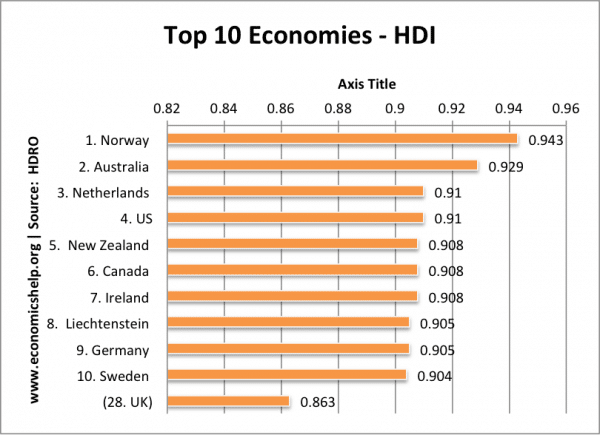Measuring living standards is important for economic policy. However, in practice, there are several difficulties in measuring living standards and therefore there are several different measures we could use.
The most common measure of living standards is to start with real GDP per Capita.
World Map of GDP per Capita

GDP per capita – GDP measures National Output / National Income. Per capita is the average income per person in the economy. This is a rough guide to living standards because it measures average incomes / the amount produced in an economy. However, income and average output is only a rough guide to living standards. (for example, increased GDP per Capita could be at the cost of increased pollution; in this case, higher GDP could lead to a decline in living standards.
GDP – Purchasing Power Parity PPP
Another important factor in measuring living standards is GDP measured at Purchasing power parity. This means that the statistics take into account the actual cost of living. For example, some countries may have lower GDP, but the cost of living is much cheaper. PPP adjusts for these different costs of living.
Real GDP per Capita / Hours Worked
A more accurate guide to living standards is to take into account the number of hours worked. If you gain high GPD per capita but have to work a 12 hour day, then this is less desirable than same income for 6 hours work per today. (measuring living standards / hours worked.)
Household expenditure/consumption
Most measures of living standards focus on income. However, income is only a rough guide to the goods and services you can actually buy. Some people may have very high living costs (e.g. rent / council tax / transport costs). Therefore, the quantity of goods and services you can actually buy will give a better guide to living standards than just income. Another issue is that some people may receive benefits in kind. E.g. those on means tested benefits often receive prescriptions and dentist visits for free. Therefore, their living standards are better than their actual income may suggest.
When comparing UK vs US, one feature of the US is that people have to devote a high % of income to health care insurance.
Poverty and Living Standards
An important factor in measuring living standards for the economy is the number of people living below the poverty line.
The poverty line is defined as:
The level of expenditure necessary to buy a minimum level of nutrition and other basic necessities. The World Bank says that the poverty line can vary somewhat from country to country, reflecting different costs of living for taking part in the everyday life of society.
Index of Human Development HDI
This is a measure which seeks to look at the available choices that people have. It is a composite indicator comprised of 3 basic factors affecting living standards – income, life expectancy and education. The three components are:
- Real GDI per Capita, adjusted for the local cost of living (PPP)
- Life expectancy
- Education – levels of literacy
The highest human development is given a value of 1. Low levels of Human development are give a value close to 0.
In 2011, the country with the highest levels of HDI was Norway with 0.943
The poorest country was the Democratic Republic of Congo with 0.286
See more details at: Human Development Index HDI
Index of Human Poverty HPI
This was introduced by the United Nations Development Programme UNDP
It is similar to the Index of Human Development, but, the HPI gives a greater weighting to examining how economic development is distributed throughout society.
Related
For more examples of the limitations in measuring living standards, view:




Thank you Tejvan Pettinger for your help. Very helpful sir.
Thank you for your helpful information